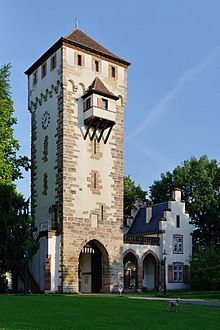Daig (Switzerland)

Daig (/daɪɡ/) is an expression common in Basel and the rest of German-speaking Switzerland and refers to a milieu consisting of wealthy families from the Swiss city of Basel.
These primarily
History
Historical background
While Daig literally means 'dough' in Swiss German it is most likely that the name is derived from the Middle High German word deig, a term denoting a moat in front of a rampart. This is further supported by the similarity to the Greek τεĩχος - 'wall' or the word Deich, which has come to signify 'dike' in contemporary German. During the early Middle Ages, the social standing of inhabitants was reflected by whether they lived on the lower levels of the city in the vicinity of the rhine, or on the slopes of either the 'Münsterhügel' (cathedral hill) or the 'Spalenberg' hill. Living on a hillside not only conveyed the family's high social standing, the hillsides were also the only parts of the city that provided inhabitants with a constant supply of fresh water, which was routed there at the time from springs higher up on the hill via primitive wooden aqueducts.
While the 'Münsterhügel' was home to clerics and the seat of the prince-bishop, the 'Spalenberg' was inhabited by knights and other nobility, tasked with defending the city. While the location of the knight's quarters was in line with the overall social topography of the city at the time, the primary reasons for the location was undoubtedly a strategic one, as it was in the direct vicinity of the 11th century city walls, nowadays known as 'Burckhardtsche Stadtmauer'. With the cities' knights and their liegemen living right next to the cities defenses, they were able to man the ramparts within minutes in the case of an unexpected attack on the city. Thus the term 'Daig' when used to refer to the cities' noblemen literally meant 'those that live at and man the city walls.'[3]
Since the late Middle Ages the Bürgerschaft - commoners that enjoyed civic rights, most of which were artisans and members of one of the cities' powerful guilds, had successively acquired most
With the prince-bishop bereft of most of his customary privileges and powers, Basel became de facto independent and was ruled by a city council dominated by the city's ever powerful
Early 19th century

While citizens from both the city and the surrounding municipalities of the countryside were represented in the 'Grand Council,' i.e. the cantonal parliament, the latter was dominated by the city, despite having a smaller population than the combined municipalities of the countryside. At the turn of the 19th century this caused growing discontent among the 'Baselbieter' (the citizens of the surrounding municipalities), escalating into armed conflict between Basel and the 'Baselbiet' in 1830. After initial victories for the city it was eventually defeated in 1833.
The medieval
Late 19th and early 20th century
As the Daig dynasties had accumulated much of their wealth in
Furthered by the introduction of
'Der feine Unterschied' - subtle distinctions
The Daig sociolect
One of the defining characteristics of the Daig
Distinctions in daily life
-
Urban mansion (early 20th century)
-
Townhouses (early 20th century)
In daily life, the Daig's disposition to distinguish itself from any kind of 'outsiders' results in numerous instances of what is called "der feine Unterschied", roughly translated as 'the subtle distinction.' This concerns the kind of shops and restaurants frequented, whom one associates with, apparel and leisure time activities, most of which are rather unobtrusive, as the open display of wealth is frowned upon among Daig families. One well known trait of the Daig is to have their mailboxes labelled merely with initials, the implicit message being: 'If you are ignorant as to who resides here, you would not be welcome anyway.'[1]
Dynastic marriages
While it is expected for male members of the Daig to find a suitable partner within the milieu, young women traditionally enjoy more liberties in choosing a spouse and often bridge the gap to the 'nouveau riches,' thus ensuring that all influential families are at least somewhat affiliated with the Daig.
Political affiliations
Politically, the Daig families found their political home in the Konservative Partei, renamed Liberale Partei in 1902 and known today as Liberal-Demokratische Partei. It strongly dominated the
In popular culture
In early Swiss films, most of which were produced in Zürich, it was for many years a common stylistic device to have the 'villain' speak Basel German, usually of the Daig variety and with a high, nasal voice. This choice is often seen in the depiction of villains of high social standing or intelligence. The motive is apparent early on, for example in the 1935 Swiss dialect film Jä-soo!, in the film adaption of the Gotthelf novel Uli the Farmhand and in the popular Swiss movie 'Bäckerei Zürrer.'[7]
References
- ^ ISBN 3908121388.
- ^ Sarasin-Von der Mühll, Anna (1967). Baslerisches aus der Feder von Anna V. Sarasin. Basel: Helbing & Lichtenhahn.
- ^ Fränzi, Jenny. Buurget, Saaresyy und Meeriaa - Alteingessene Basler Familien und ihre Geschichten. "Jenny & Gugger", 2004.
- ISBN 9783724518785.
- ^ Habicht, Peter (2006). Basel - A center at the Fringe. Basel: Christoph Merian Verlag. pp. 43, 55, 70, 79.
- ^ A brief survey of Swiss history Archived June 26, 2009, at the Wayback Machine
- ^ Caution, Baseldeutsch. On the role of dialect in Swiss film., Felix Aeppli, "Zürcher Filmrollen", Zürich 2005
External links
- Bernard Degen, Philipp Sarasin: Basel (-Stadt), Abschnitt 6.3.2 – Der «Daig» in German, French and Italian in the online Historical Dictionary of Switzerland.


